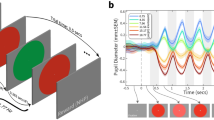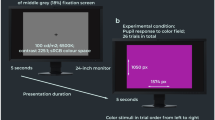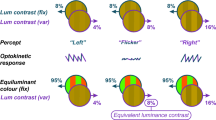Abstract
IN 1948 the German physicist, Manfred Richter, reported that colour vision has a seasonal variation1,2. For four colour-normal subjects, he found a sinusoidal variation in the proportion of red and green required to match a monochromatic yellow, the equation known as the 'Rayleigh match'3. In summer, subjects required more red in their mixture. The measurements were made with the Nagel anomaloscope, an instrument introduced in 19074,5 and which today, essentially unchanged, remains the definitive clinical instrument for classifying the many phenotypic variations in colour vision. The variation that Richter recorded in the red–green ratio was large (three Nagel units), and it now takes on fresh interest because it is comparable in size to the difference in Nagel settings later reported between normal observers of different genetic types6,7. We have been able to replicate Richter's result, but report here that it is almost certainly instrumental: the Nagel anomaloscope proves to be very sensitive to ambient temperature.
This is a preview of subscription content, access via your institution
Access options
Subscribe to this journal
Receive 51 print issues and online access
$199.00 per year
only $3.90 per issue
Buy this article
- Purchase on Springer Link
- Instant access to full article PDF
Prices may be subject to local taxes which are calculated during checkout
Similar content being viewed by others
References
Richter, M. Z. wíss. Photogr. Photophy. Photoch. 43, 209–237 (1948).
Richter, M. Klin. Mon. Augenheilkunde 119, 561–575 (1951).
Rayleigh, L. Nature 25, 64–66 (1881).
Nagel, W. A. Z. Augenheilkunde 18, 201–222 (1907).
Nagel, W. in Handbuch der Physiologischen Methodik (ed. Tigerstedt, R.) (Hirzel, Leipzig. 1909).
Waaler, G. H. M. Nature 215, 406 (1967).
Waaler, G. H. M. Avhandl. Det Norske Videnskaps-Akad. Oslo I Mat.-Naturv. Klasse. Ny Serie, No. 9, 1–25 (1967).
Pokorny, J., Smith, V. C., Verriest, G. & Pinckers, A. J. L. G. Congenital and Acquired Color Vision Defects (Grune & Stratton, New York, 1979).
De Vries, H. Experientia 4, 357 (1948).
Knowles, A. Vision Res. 20, 475–485 (1980).
Moreland, J. D. in Colour Vision Deficiencies II (ed. Verriest, G.) 14–18 (Karger, Basel, 1974).
Merton, T. R. Proc. R. Soc. 113, 704–708 (1927).
Winderickx, J. et al. Nature Genet. 1, 251–255 (1992).
Köllner, H. Arch. Augenheilkunde 78, 302–335 (1915).
Jordan, G. Polymorphism of Normal Colour Vision in Humans (University of Cambridge, Cambridge, 1992).
Heinsius, E. Farbsinnstörungen und ihre Prüfung in der Praxis (Ferdinand Enke, Stuttgart, 1973).
Author information
Authors and Affiliations
Rights and permissions
About this article
Cite this article
Jordan, G., Mollon, J. The Nagel anomaloscope and seasonal variation of colour vision. Nature 363, 546–549 (1993). https://doi.org/10.1038/363546a0
Received:
Accepted:
Issue Date:
DOI: https://doi.org/10.1038/363546a0
This article is cited by
-
Dynamic plasticity in phototransduction regulates seasonal changes in color perception
Nature Communications (2017)
-
The Nagel anomaloscope: its calibration and recommendations for diagnosis and research
Graefe's Archive for Clinical and Experimental Ophthalmology (2005)
-
Adaptation of colour vision to sunlight
Nature (1997)
Comments
By submitting a comment you agree to abide by our Terms and Community Guidelines. If you find something abusive or that does not comply with our terms or guidelines please flag it as inappropriate.



